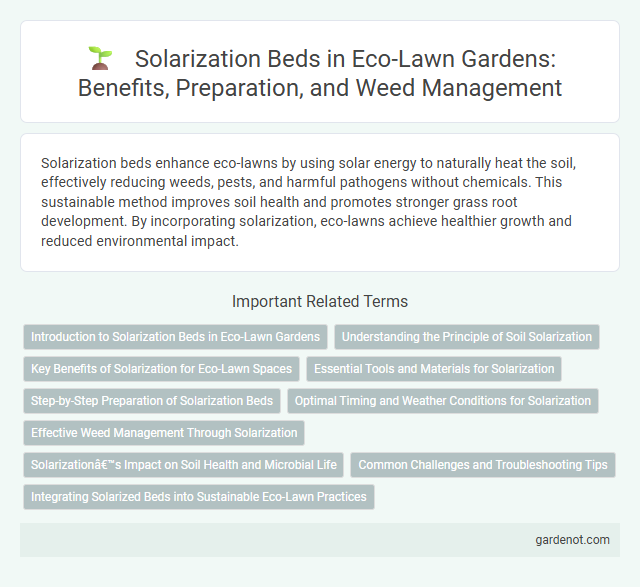Solarization beds enhance eco-lawns by using solar energy to naturally heat the soil, effectively reducing weeds, pests, and harmful pathogens without chemicals. This sustainable method improves soil health and promotes stronger grass root development. By incorporating solarization, eco-lawns achieve healthier growth and reduced environmental impact.
Introduction to Solarization Beds in Eco-Lawn Gardens
Solarization beds harness solar energy to naturally sterilize soil, effectively reducing pests, weeds, and pathogens without chemicals. This eco-friendly technique enhances soil health by increasing beneficial microorganisms and nutrient availability, making it ideal for sustainable eco-lawn gardens. Implementing solarization beds promotes vigorous grass growth and a resilient, chemical-free lawn ecosystem.
Understanding the Principle of Soil Solarization
Soil solarization is an eco-friendly method that utilizes solar energy to heat the soil, effectively controlling pests, weeds, and soil-borne diseases by raising the temperature to levels that inhibit their development. This process involves covering moist soil with transparent polyethylene sheets during peak sun exposure, typically for 4 to 6 weeks, maximizing thermal absorption and sterilizing the upper soil layers. Solarization improves soil health by reducing harmful pathogens while preserving beneficial microorganisms, promoting sustainable growth in eco-lawn maintenance.
Key Benefits of Solarization for Eco-Lawn Spaces
Solarization bed enhances eco-lawn spaces by using solar heat to naturally eliminate soil-borne pests, weeds, and pathogens without harmful chemicals, promoting sustainable lawn care. This method improves soil aeration and nutrient availability, leading to healthier grass growth and reduced reliance on synthetic fertilizers. Solarization also conserves water by increasing soil moisture retention, supporting drought-resistant eco-lawn ecosystems.
Essential Tools and Materials for Solarization
Effective solarization beds require essential tools such as clear polyethylene sheets with a thickness of 1 to 6 mils to trap solar heat efficiently. Soil preparation tools include a rototiller or garden fork for loosening the soil to a depth of 6 to 12 inches, ensuring optimal heat penetration. Additional materials include water for moistening the soil to enhance thermal conductivity and stakes or weights to secure the plastic cover and prevent heat loss during the solarization process.
Step-by-Step Preparation of Solarization Beds
Solarization beds require thorough soil preparation by removing debris and tilling the area to a depth of 6 to 12 inches for optimal heat penetration. After leveling the soil, moisten it evenly to enhance microbial activity and heat conduction. Cover the bed tightly with clear polyethylene plastic, securing edges with soil or weights to trap solar heat and effectively eliminate weeds and pathogens within 4 to 6 weeks.
Optimal Timing and Weather Conditions for Solarization
Solarization beds require optimal timing during the hottest months, typically late spring to mid-summer, to maximize soil temperature elevation and effectively eliminate weeds and pathogens. Ideal weather conditions include consistent, intense sunlight and minimal cloud cover for at least 4 to 6 weeks, ensuring the soil reaches temperatures between 110degF and 130degF (43degC to 54degC). Proper timing and weather assessment enhance solarization efficiency, promoting a healthy, weed-free eco-lawn establishment.
Effective Weed Management Through Solarization
Solarization bed uses solar energy captured under clear plastic sheets to raise soil temperatures between 45-60degC, effectively eradicating weed seeds, pathogens, and soil-borne pests. This sustainable weed management technique reduces reliance on chemical herbicides and enhances soil health by promoting beneficial microbial activity. Solarization typically requires 4-6 weeks of exposure during peak sun months to achieve optimal weed control in eco-lawn preparation.
Solarization’s Impact on Soil Health and Microbial Life
Solarization bed techniques significantly improve soil health by using solar energy to raise soil temperature, effectively reducing soil-borne pathogens and weed seeds. This process enhances microbial life by selectively encouraging beneficial microorganisms that support nutrient cycling and plant growth. The overall impact results in healthier soil ecosystems, promoting sustainable eco-lawn maintenance.
Common Challenges and Troubleshooting Tips
Solarization beds often face challenges like uneven soil heating and extended treatment duration, which can reduce weed and pest elimination efficiency. To optimize solarization, ensure the plastic tarp is securely anchored to maintain consistent soil temperature and prevent heat loss. Monitoring soil moisture and adjusting irrigation can also enhance microbial activity and improve pest control results.
Integrating Solarized Beds into Sustainable Eco-Lawn Practices
Integrating solarized beds into sustainable eco-lawn practices enhances soil health by naturally eliminating weeds and pathogens through solarization's heat treatment. This method reduces reliance on chemical herbicides, promoting an eco-friendly lawn ecosystem that supports biodiversity and water retention. Solarized beds improve soil structure and nutrient availability, fostering robust, drought-resistant turf essential for sustainable landscaping.
Solarization bed Infographic

 gardenot.com
gardenot.com